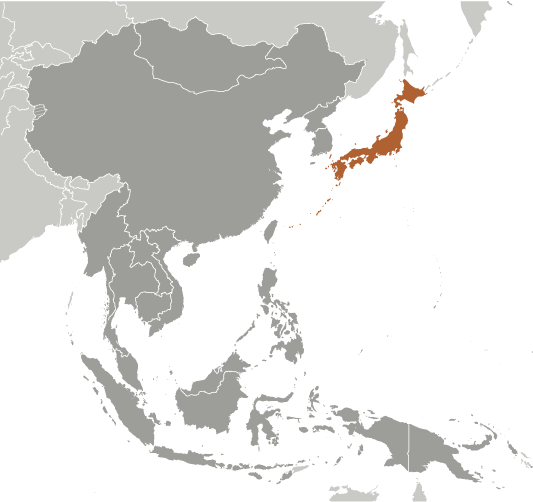
|
|
Advertisements:
People And SocietyNationality
Noun Japanese (singular and plural)
Adjective Japanese Ethnic groups
Japanese 98.5%, Koreans 0.5%, Chinese 0.4%, other 0.6% Note Up to 230,000 Brazilians of Japanese origin migrated to Japan in the 1990s to work in industries; some have returned to Brazil (2004) Languages
Japanese
Religions
Shintoism 83.9%, Buddhism 71.4%, Christianity 2%, other 7.8% Note Total adherents exceeds 100% because many people belong to both Shintoism and Buddhism (2005) Population World Ranking: 10
127,368,088 (July 2012 est.)
Age structure
0-14 years
13.1% (male 8,521,571/female 8,076,173) 15-64 years 64% (male 40,815,840/female 40,128,235) 65 years and over 22.9% (male 12,275,829/female 16,658,016) (2011 est.) Median age
Total 45.4 years
Male 44.1 years Female 46.9 years (2012 est.) Population growth rate World Ranking: 199
-0.077% (2012 est.)
Birth rate World Ranking: 216
8.39 births/1,000 population (2012 est.) Death rate World Ranking: 63
9.15 deaths/1,000 population (July 2012 est.) Net migration rate World Ranking: 91
0 migrant(s)/1,000 population (2012 est.) Urbanization
Urban population 67% of total population (2010)
Rate of urbanization 0.2% annual rate of change (2010-15 est.) Major cities - population
TOKYO (capital) 36.507 million; Osaka-Kobe 11.325 million; Nagoya 3.257 million; Fukuoka-Kitakyushu 2.809 million; Sapporo 2.673 million (2009) Sex ratio
At birth 1.06 male(s)/female
Under 15 years 1.08 male(s)/female 15-64 years 1 male(s)/female 65 years and over 0.76 male(s)/female Total population 0.94 male(s)/female (2011 est.) Maternal mortality rate World Ranking: 173
5 deaths/100,000 live births (2010) Infant mortality rate World Ranking: 221
Total 2.21 deaths/1,000 live births
Male 2.44 deaths/1,000 live births Female 1.97 deaths/1,000 live births (2012 est.) Life expectancy at birth World Ranking: 3
Total population 83.91 years
Male 80.57 years Female 87.43 years (2012 est.) Total fertility rate World Ranking: 203
1.39 children born/woman (2012 est.) Health expenditures World Ranking: 41
9.3% of GDP (2009)
Physicians density
2.063 physicians/1,000 population (2006) Hospital bed density
13.75 beds/1,000 population (2008) Hiv/aids - adult prevalence rate World Ranking: 131
Less than 0.1% (2009 est.)
Hiv/aids - people living with hiv/aids World Ranking: 108
8,100 (2009 est.)
Hiv/aids - deaths World Ranking: 117
Fewer than 100 (2009 est.)
Obesity - adult prevalence rate World Ranking: 65
3.1% (2000)
Education expenditures World Ranking: 118
3.5% of GDP (2007)
Literacy
Definition
Age 15 and over can read and write Total population 99%Male 99% Female 99% (2002) School life expectancy (primary to tertiary education)
Total 15 years
Male 15 years Female 15 years (2008) Unemployment, youth ages 15-24 World Ranking: 109
Total 9.1%
Male 10.1% Female 8% (2009)
Comments
Add a new comment: |
Advertisement
Members area
Japan (Tokyo):
 
GPS points from Japan (Tokyo)
|
||||||||

 In 1603, after decades of civil warfare, the Tokugawa shogunate (a military-led, dynastic government) ushered in a long period of relative political stability and isolation from foreign influence. For more than two centuries this policy enabled Japan to enjoy a flowering of its indigenous culture. Japan opened its ports after signing the Treaty of Kanagawa with the US in 1854 and began to intensively modernize and industrialize. During the late 19th and early 20th centuries, Japan became a regional power that was able to defeat the forces of both China and Russia. It occupied Korea, Formosa (Taiwan), and southern Sakhalin Island. In 1931-32 Japan occupied Manchuria, and in 1937 it launched a full-scale invasion of China. Japan attacked US forces in 1941 - triggering America's entry into World War II - and soon occupied much of East and Southeast Asia. After its defeat in World War II, Japan recovered to become an economic power and an ally of the US. While the emperor retains his throne as a symbol of national unity, elected politicians hold actual decision-making power. Following three decades of unprecedented growth, Japan's economy experienced a major slowdown starting in the 1990s, but the country remains a major economic power. In March 2011, Japan's strongest-ever earthquake, and an accompanying tsunami, devastated the northeast part of Honshu island, killing thousands and damaging several nuclear power plants. The catastrophe hobbled the country's economy and its energy infrastructure, and tested its ability to deal with humanitarian disasters.
In 1603, after decades of civil warfare, the Tokugawa shogunate (a military-led, dynastic government) ushered in a long period of relative political stability and isolation from foreign influence. For more than two centuries this policy enabled Japan to enjoy a flowering of its indigenous culture. Japan opened its ports after signing the Treaty of Kanagawa with the US in 1854 and began to intensively modernize and industrialize. During the late 19th and early 20th centuries, Japan became a regional power that was able to defeat the forces of both China and Russia. It occupied Korea, Formosa (Taiwan), and southern Sakhalin Island. In 1931-32 Japan occupied Manchuria, and in 1937 it launched a full-scale invasion of China. Japan attacked US forces in 1941 - triggering America's entry into World War II - and soon occupied much of East and Southeast Asia. After its defeat in World War II, Japan recovered to become an economic power and an ally of the US. While the emperor retains his throne as a symbol of national unity, elected politicians hold actual decision-making power. Following three decades of unprecedented growth, Japan's economy experienced a major slowdown starting in the 1990s, but the country remains a major economic power. In March 2011, Japan's strongest-ever earthquake, and an accompanying tsunami, devastated the northeast part of Honshu island, killing thousands and damaging several nuclear power plants. The catastrophe hobbled the country's economy and its energy infrastructure, and tested its ability to deal with humanitarian disasters.